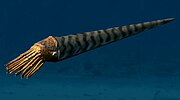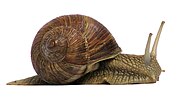Nautiloids are a group of marine cephalopods (Mollusca) which originated in the Late Cambrian and are represented today by the living Nautilus and Allonautilus...
37 KB (3,465 words) - 00:34, 3 November 2024
coleoids (i.e., octopuses, squid and cuttlefish) than they are to shelled nautiloids (such as the living Nautilus). The earliest ammonoids appeared during...
52 KB (5,802 words) - 23:24, 29 October 2024
chambers enclosed between two adjacent septa in the phragmocone of a nautiloid or ammonoid cephalopod molluscus. These can be seen in cross-sections...
1 KB (131 words) - 04:55, 21 May 2024
is the long, cone-shaped shell belonging to several species of ancient nautiloid cephalopod—the prehistoric ancestors of today's marine cephalopod mollusks...
4 KB (414 words) - 10:21, 22 April 2024
Orthoceras is a genus of extinct nautiloid cephalopod restricted to Middle Ordovician-aged marine limestones of the Baltic States and Sweden. This genus...
5 KB (437 words) - 01:31, 30 October 2024
Cambrian-Ordovician extinction event, the niches of large carnivores were taken over by nautiloid cephalopods such as Cameroceras and later eurypterids such as Jaekelopterus...
20 KB (2,004 words) - 20:09, 3 November 2024
be the upper surface. All cephalopods with external shells except the nautiloids became extinct by the end of the Cretaceous period 65 million years ago...
98 KB (9,823 words) - 07:55, 4 November 2024
became dominant during the Ordovician period, represented by primitive nautiloids. The class now contains two, only distantly related, extant subclasses:...
139 KB (15,486 words) - 14:22, 6 November 2024
Multiceratoidea is a major subclass or superorder of Paleozoic nautiloid cephalopods. Members of this group can be characterized by nautilosiphonate connecting...
6 KB (564 words) - 12:40, 14 October 2024
This list of nautiloids is a comprehensive listing of all genera that have ever been included in the subclass Nautiloidea, excluding purely vernacular...
39 KB (1,168 words) - 21:27, 30 April 2024









